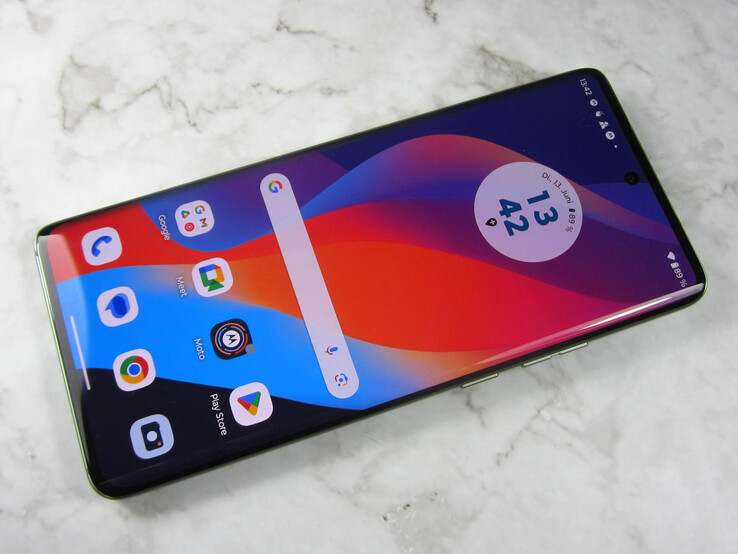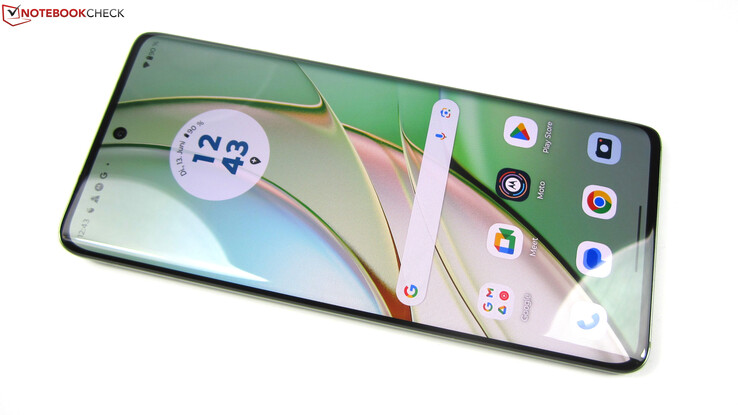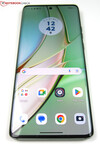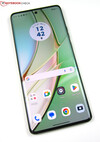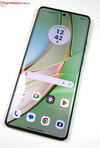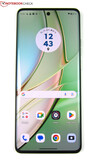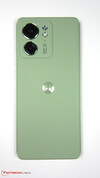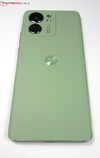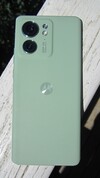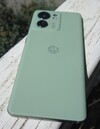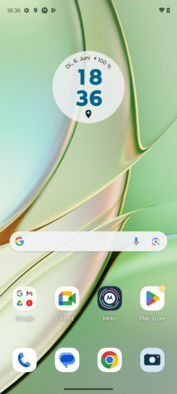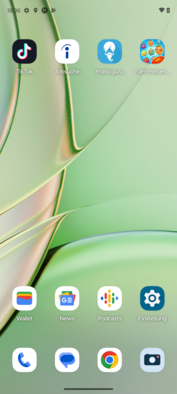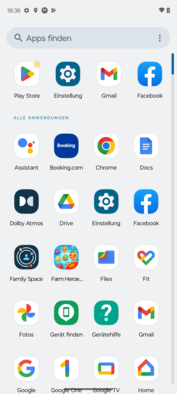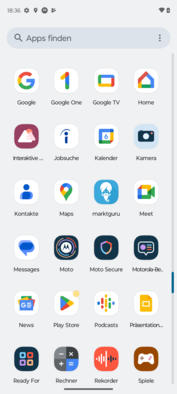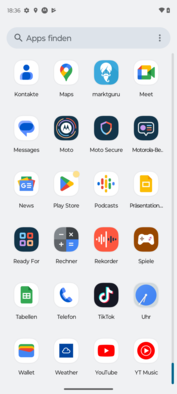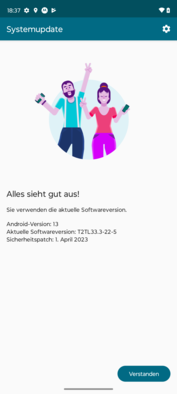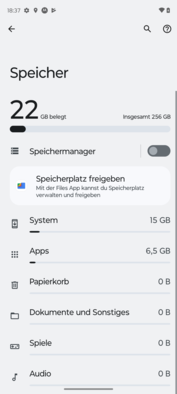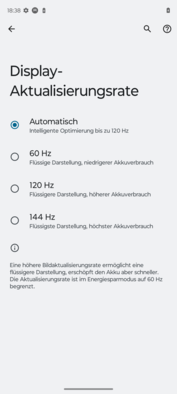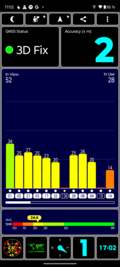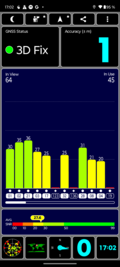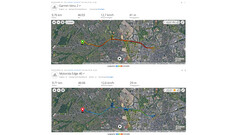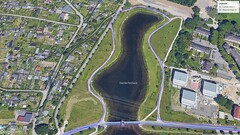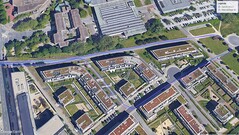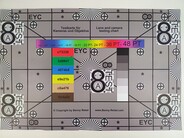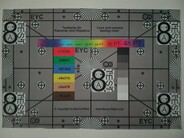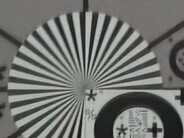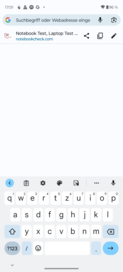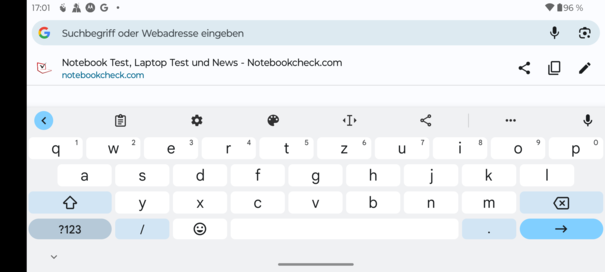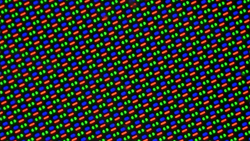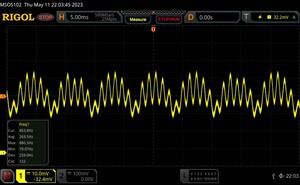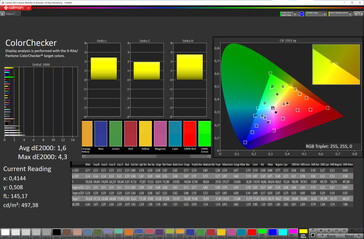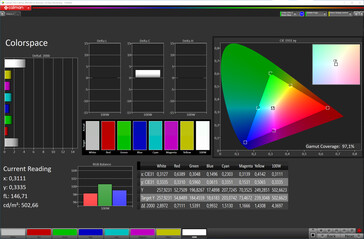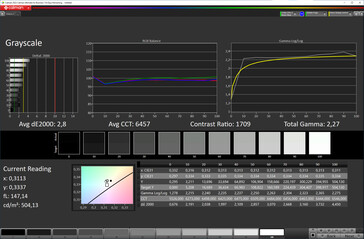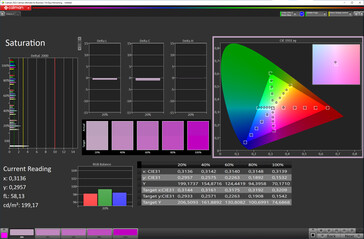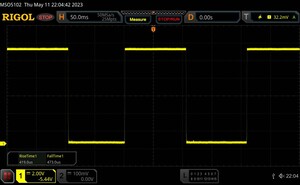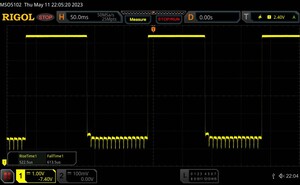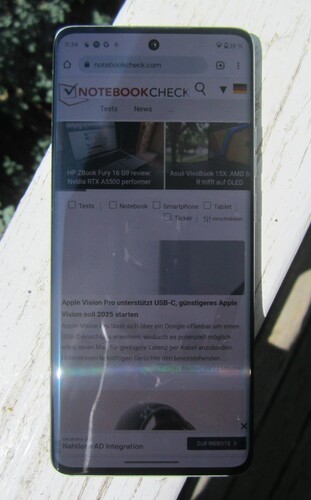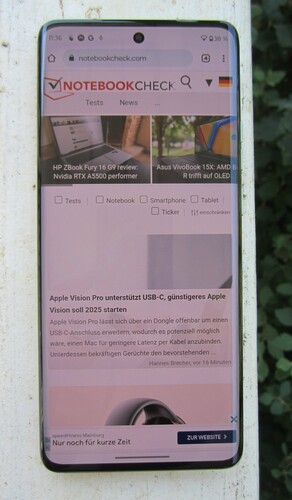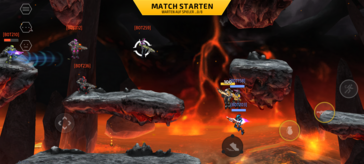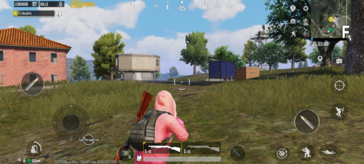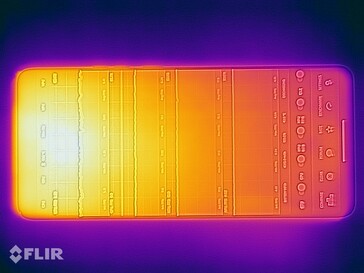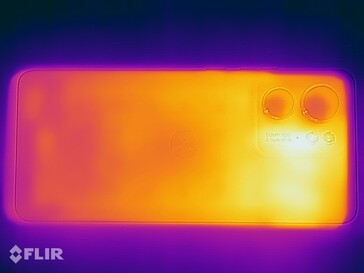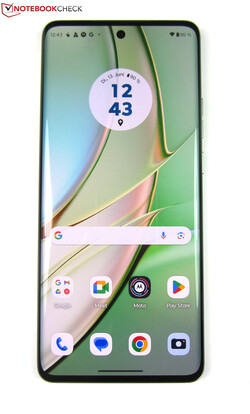Motorola Edge 40 review: Slim lightweight with vegan leather case
The Edge 40 is Motorola's inexpensive version of its flagship smartphone, the Edge 40 Pro. Around US$300 cheaper than the latter, the Edge 40 offers a wide range of equipment at a fair price.
The Snapdragon 8 Gen 2 of the flagship is not used in the Edge 40, but rather the solid, midrange MediaTek Dimensity 8020. Our test candidate also offers less RAM (8 versus 12 GB) and is only equipped with two camera sensors instead of three, but these also generate a resolution of 50 MP.
The OLED screen of the Edge 40 is slightly smaller than that of the 6.67-inch Edge 40 Pro at 6.55 inches and also has a resolution of 2400 x 1080 pixels. Due to the smaller form factor, the Edge 40 thus has a slightly higher pixel density (402 vs 394 PPI). The refresh rate ends at 144 Hz, whereas the Edge 40 Pro manages up to 165 Hz.
Possible competitors in comparison
Rating | Date | Model | Weight | Drive | Size | Resolution | Price |
|---|---|---|---|---|---|---|---|
| 86.8 % v7 (old) | 07 / 2023 | Motorola Edge 40 Dimensity 8020, Mali-G77 MP9 | 171 g | 256 GB UFS 3.1 Flash | 6.55" | 2400x1080 | |
| 88.5 % v7 (old) | 11 / 2022 | Google Pixel 7 Tensor G2, Mali-G710 MP7 | 197 g | 128 GB UFS 3.1 Flash | 6.30" | 2400x1080 | |
| 86.4 % v7 (old) | 07 / 2022 | Motorola Edge 30 SD 778G+ 5G, Adreno 642L | 155 g | 128 GB UFS 3.1 Flash | 6.50" | 2400x1080 | |
| 85.6 % v7 (old) | 07 / 2022 | Nothing Phone (1) SD 778G+ 5G, Adreno 642L | 193.5 g | 256 GB UFS 3.1 Flash | 6.55" | 2400x1080 | |
| 86 % v7 (old) | 05 / 2023 | Samsung Galaxy A54 5G Exynos 1380, Mali-G68 MP5 | 202 g | 128 GB UFS 2.2 Flash | 6.40" | 2340x1080 | |
| 87.7 % v7 (old) | 11 / 2022 | Xiaomi 12T Pro 5G SD 8+ Gen 1, Adreno 730 | 205 g | 256 GB UFS 3.1 Flash | 6.67" | 2712x1220 |
Case - Lightweight with acrylic or faux leather back
The Edge 40 has the same design language as the Edge 40 Pro. The slim smartphone's corners and edges are just as rounded as the screen's long sides and converge into a thin aluminum frame. Overall, the Edge 40 is excellently manufactured and makes a valuable and robust impression. At a height of 7.49 millimeters and a maximum weight of 171 grams, it is very light and thin for a smartphone of its size.
If you opt for Eclipse Black, Nebula Green or Viva Magenta, these come with a back cover made of vegan leather, which makes the smartphone very easy to grip. Overall, the Edge feels much more secure to hold than the Edge 40 Pro, which has a glass back, as is typical for a high-end smartphone. In the fourth color variant, Lunar Blue, the Edge 40 is even lighter at just 167 grams. However, the back is made of matte acrylic instead of vegan leather.
The Edge 40 is IP68 certified, namely water- and dust resistant. This allows for submersion in shallow water for a few minutes without damage (up to 30 minutes in 1.5 meters of fresh water). Motorola does not specify the protection class of the display glass.
Equipment - Dual SIM with nano SIM & eSIM
The Motorola Edge 40 comes with the same memory configuration in every color variant, consisting of 8 GB of LPDDR4X RAM and 256 GB of UFS 3.1 flash. Expansion is not possible due to the lack of a microSD slot.
The Edge 40's USB-C port operates at USB 2.0 speeds and supports USB OTG. It also has to be used to connect wired audio devices due to the lack of a 3.5 mm jack.
Only a nano-SIM card fits in the SIM card slot, but an eSIM profile can also be activated in the settings. In addition to NFC and Bluetooth 5.2, the smartphone supports DRM Widevine L1. The latter enables the playback of high-resolution content from streaming services.
Software - Update to Android 14 guaranteed
Motorola equips the Edge 40 with a near-stock Android 13. There are only a handful of software additions, such as the proprietary Moto and Ready For apps. A few third-party apps such as TikTok or Marktguru also come preinstalled, but these can all be uninstalled.
According to the support website, Motorola guarantees one OS upgrade to Android 14. The manufacturer does not reveal how many upgrades there will actually be in the end, but you can certainly assume two OS upgrades. The Android security updates are more specific because the Edge 40 is slated to receive them every two months until January 2028. At the time of review in mid-June, the security patches were from April 1 and thus still up to date by Motorola's standards.
Like the Edge 40 Pro, the Edge 40 is also equipped with Motorola's Ready For technology, which, unlike the flagship, does not support USB-C connections, but only wireless connections. The Edge 40 screen content can be mirrored on a TV, external monitor, PC or tablet via Ready For.
Communication and GNSS - Motorola Edge 40 with WiFi 6
Hardly any mid-range smartphone comes without WiFi 6 nowadays, and the Edge 40 is no exception either. It cannot utilize the 6 GHz band for transmissions, but still achieves fast and stable transfer rates in tandem with our Asus ROG Rapture AXE 11000 reference router. The peak rate is 942 MBit/s, which makes the Edge 40 one of the fastest smartphones among the comparison devices. The Google Pixel 7 is even faster with its data throughput in the 6 GHz band.
| Networking | |
| iperf3 receive AXE11000 | |
| Google Pixel 7 | |
| Samsung Galaxy A54 5G | |
| Motorola Edge 40 | |
| Average of class Smartphone (52 - 1857, n=176, last 2 years) | |
| Xiaomi 12T Pro 5G | |
| iperf3 transmit AXE11000 | |
| Motorola Edge 40 | |
| Google Pixel 7 | |
| Xiaomi 12T Pro 5G | |
| Samsung Galaxy A54 5G | |
| Average of class Smartphone (49.8 - 1806, n=176, last 2 years) | |
| iperf3 transmit AXE11000 6GHz | |
| Google Pixel 7 | |
| Average of class Smartphone (508 - 1945, n=86, last 2 years) | |
| Motorola Edge 30 | |
| Nothing Phone (1) | |
| iperf3 receive AXE11000 6GHz | |
| Google Pixel 7 | |
| Average of class Smartphone (451 - 1864, n=86, last 2 years) | |
| Motorola Edge 30 | |
| Nothing Phone (1) | |
The Edge 40 uses the GPS (L1, L5), Glonass (L1), Galileo (E1, E5a) and Beidou (B1, B2a) satellite navigation services to determine its location. The smartphone thus achieves a very precise location when stationary. Our position is pinpointed at an accuracy of up to 2 meters indoors and up to 1 meter outdoors.
To test the Edge 40's real-world navigation skills, we took it on a 10 km bike ride. Apart from small outliers, the smartphone records the route taken almost as precisely as the Garmin Venu 2 fitness smartwatch, which was used for direct comparison. All in all, the Edge 40 is quite suitable for navigational tasks.
Telephony and Voice Quality
The Edge 40 supports all common cellular standards apart from 5G Sub6. With 21 4G bands and 14 5G bands, it offers solid frequency coverage, so you should get reception at almost any location.
When making calls, the smartphone transmits our voice quite clearly and understandably to our conversation partner, even in hands-free mode. VoLTE and WiFi calling are supported.
In the Android settings, the Edge 40 displays its SAR values under the About phone and Regulatory approvals menu items. At 0.99 W/kg (head SAR) and 1.49 W/kg (body SAR), they are in a normal range.
Cameras - Bright dual camera with OmniVision OV50A
The Edge 40 has a similar camera setup as the Edge 40 Pro, although it lacks a telephoto lens. This leaves a 50 MP main camera, a 13 MP ultra wide-angle camera and a 32 MP selfie camera. The latter takes good pictures with decent image sharpness in daylight. Like the main camera, it can record videos at a maximum of 4K at 30 FPS.
The 50 MP main camera uses the OmniVision OV50A as the image sensor and takes 12 MP shots via 4-in-1 pixel binning. Thanks to its large aperture of f/2.4 and the optical image stabilizer, it takes surprisingly good and low-noise shots in low residual light. Daytime photos are also convincing with natural colors and a lot of detail, even in dark areas of the image.
The ultra-wide-angle camera (Hynix HI1336) covers a 120° field of view and has a resolution of 13 MP. In terms of detail richness and sharpness, it cannot compete with the main camera, but it does its job quite well. Towards the edges of the image, however, the image becomes quite blurry.
Image comparison
Choose a scene and navigate within the first image. One click changes the position on touchscreens. One click on the zoomed-in image opens the original in a new window. The first image shows the scaled photograph of the test device.
Daylight photo 1Daylight photo 2Ultra wide angle5x zoomLow lightIn the test lab, we took a closer look at the main camera in certain lighting situations. It reproduces colors quite accurately in optimal lighting and displays the test chart cleanly and sharply. The color fidelity remains comparatively high in 1 lux residual light and the test chart is still completely visible, but no longer particularly sharp.
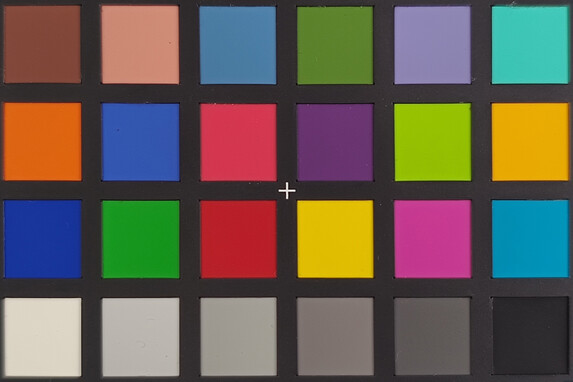
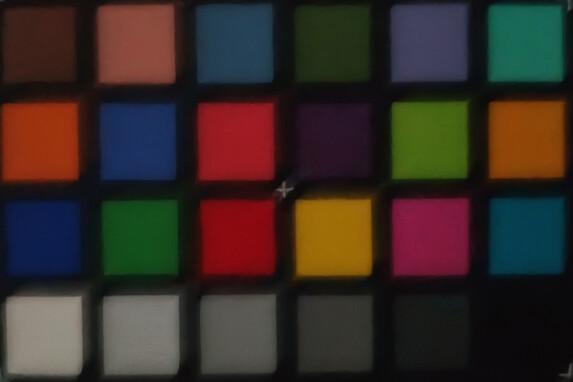
Accessories and Warranty - 68-watt power supply included
The Edge 40 comes with a 68-watt power supply (11V/6.2A), a USB-C cable, a SIM needle, a protective case and a quick start guide. A number of accessories, such as headsets and Bluetooth speakers, are available in Motorola's store.
The Edge 40 comes with a 24-month warranty. There is also the option of extending the guarantee to 3 years with the Moto Care insurance cover and adding accident cover.
Input Devices & Operation - 144 Hz and gesture control
The Edge 40's 144 Hz display ensures that content is displayed smoothly. The responsivity is also good, as the touchscreen is scanned 360 times per second and reacts very precisely to inputs. The display glass is curved on the long sides, which makes the edges particularly narrow. One could be forgiven for assuming that this might result in increased input errors, but we did not encounter any during the course of our tests.
The Edge 40's fingerprint sensor is located under the display, detects scanned fingers reliably and unlocks the smartphone very quickly. Unlocking via facial recognition also works with virtually no delay. Since authentication takes place via 2D software, a sufficiently bright environment is required for this. In dark environments, the residual light of the display is usually sufficient for Face Unlock.
In everyday life, the Edge 40 provides users with practical gesture control. For example, if you make a double chopping motion with the smartphone in your hand, the flashlight is switched on. If you turn your wrist twice, the camera starts. Another practical feature is that if you receive a call or a notification, the edges of the display light up by default. The Edge 40 does not have an always-on display.
Display - OLED with four-digit brightness
According to Motorola, the Edge 40's HDR10+ compatible OLED display with a resolution of 2400 x 1080 pixels is supposed to have a peak brightness of up to 1200 nits. The smartphone even surpasses this mark in our tests, achieving up to 1345 cd/m² in the APL18 test.
If you extend the measurement from the small image section to the full screen, the result doesn't look much worse. The Edge 40 still achieves a very good 1042 cd/m² and is thus practically on par with the Edge 40 Pro (1055 cd/m²). It clearly outperforms its Edge 30 predecessor with its maximum brightness of 655 cd/m². With the brightness sensor deactivated, the OLED display achieves a maximum of 510 cd/m², and 3.41 cd/m² at the lowest brightness level.
The Edge 40 uses pulse width modulation (PWM) for brightness control. The PWM flickering largely corresponds to the refresh rate at all brightness levels and should therefore not be an issue. However, there are quite a few PWM outliers, so sensitive users could certainly be affected. The Prevent flickering button in the Display Settings can help, as it prevents the display from flickering in dark environments.
| |||||||||||||||||||||||||
Brightness Distribution: 90 %
Center on Battery: 1023 cd/m²
Contrast: ∞:1 (Black: 0 cd/m²)
ΔE ColorChecker Calman: 1.6 | ∀{0.5-29.43 Ø4.81}
ΔE Greyscale Calman: 2.8 | ∀{0.09-98 Ø5.1}
97.1% sRGB (Calman 2D)
Gamma: 2.27
CCT: 6457 K
| Motorola Edge 40 OLED, 2400x1080, 6.6" | Google Pixel 7 OLED, 2400x1080, 6.3" | Motorola Edge 30 AMOLED, 2400x1080, 6.5" | Nothing Phone (1) OLED, 2400x1080, 6.6" | Samsung Galaxy A54 5G Super AMOLED, 2340x1080, 6.4" | Xiaomi 12T Pro 5G AMOLED, 2712x1220, 6.7" | |
|---|---|---|---|---|---|---|
| Screen | 16% | -6% | 6% | -2% | 17% | |
| Brightness middle (cd/m²) | 1023 | 936 -9% | 632 -38% | 620 -39% | 940 -8% | 913 -11% |
| Brightness (cd/m²) | 1042 | 947 -9% | 630 -40% | 625 -40% | 935 -10% | 913 -12% |
| Brightness Distribution (%) | 90 | 95 6% | 92 2% | 98 9% | 99 10% | 95 6% |
| Black Level * (cd/m²) | ||||||
| Colorchecker dE 2000 * | 1.6 | 1.3 19% | 1.46 9% | 1.24 22% | 2.4 -50% | 1 37% |
| Colorchecker dE 2000 max. * | 4.3 | 2.7 37% | 3.32 23% | 2.31 46% | 3.2 26% | 2.4 44% |
| Greyscale dE 2000 * | 2.8 | 1.4 50% | 2.6 7% | 1.7 39% | 2.2 21% | 1.8 36% |
| Gamma | 2.27 97% | 2.25 98% | 2.209 100% | 2.318 95% | 2.05 107% | 2.23 99% |
| CCT | 6457 101% | 6664 98% | 6755 96% | 6325 103% | 6422 101% | 6273 104% |
* ... smaller is better
Screen Flickering / PWM (Pulse-Width Modulation)
| Screen flickering / PWM detected | 144 Hz | ||
The display backlight flickers at 144 Hz (worst case, e.g., utilizing PWM) . The frequency of 144 Hz is very low, so the flickering may cause eyestrain and headaches after extended use. In comparison: 53 % of all tested devices do not use PWM to dim the display. If PWM was detected, an average of 8255 (minimum: 5 - maximum: 343500) Hz was measured. | |||
Series of measurements at a fixed zoom level and different brightness settings
The color representation of the OLED display can be adjusted using the Saturated and Natural color profiles. In addition, you can change the color temperature in seven levels between cool and warm. Picture quality is best under Natural. Colors and grayscale are in the ideal range with a Delta-E of <3, and the RGB balance is also quite balanced.
Display Response Times
| ↔ Response Time Black to White | ||
|---|---|---|
| 0.89 ms ... rise ↗ and fall ↘ combined | ↗ 0.419 ms rise | |
| ↘ 0.473 ms fall | ||
| The screen shows very fast response rates in our tests and should be very well suited for fast-paced gaming. In comparison, all tested devices range from 0.1 (minimum) to 240 (maximum) ms. » 2 % of all devices are better. This means that the measured response time is better than the average of all tested devices (20.4 ms). | ||
| ↔ Response Time 50% Grey to 80% Grey | ||
| 1.14 ms ... rise ↗ and fall ↘ combined | ↗ 0.5225 ms rise | |
| ↘ 0.6135 ms fall | ||
| The screen shows very fast response rates in our tests and should be very well suited for fast-paced gaming. In comparison, all tested devices range from 0.165 (minimum) to 636 (maximum) ms. » 4 % of all devices are better. This means that the measured response time is better than the average of all tested devices (31.9 ms). | ||
Performance - MediaTek Dimensity 8020 for the Motorola smartphone
Motorola equips the Edge 40 with the MediaTek Dimensity 8020. The eight-core SoC works with 8 cores, which are divided into four ARM Cortex A78 performance cores (2.6 GHz) and four ARM Cortex A55 energy-saving cores (2 GHz). The ARM Mali-G77 MP9 serves as the integrated graphics unit.
The Dimensity 8020 is far from being able to compete with the Snapdragon 8 Gen 2 in the Edge 40 Pro, but it delivers solid midrange performance. This is also enough to beat quite a few rivals, including the Samsung Galaxy A54 5G and its Exynos 1380 SoC, as well as the Nothing Phone (1), which is powered by the Snapdragon 778G+ 5G. Among the comparison devices, the Google Pixel 7 with its Tensor G2 is the toughest competitor for the Edge 40.
| UL Procyon AI Inference for Android - Overall Score NNAPI | |
| Xiaomi 12T Pro 5G | |
| Google Pixel 7 | |
| Motorola Edge 40 | |
| Average MediaTek Dimensity 8020 (n=1) | |
| Nothing Phone (1) | |
| Motorola Edge 30 | |
| Average of class Smartphone (3769 - 81594, n=139, last 2 years) | |
| Samsung Galaxy A54 5G | |
| AImark - Score v3.x | |
| Average of class Smartphone (82 - 307528, n=128, last 2 years) | |
| Motorola Edge 40 | |
| Average MediaTek Dimensity 8020 (n=1) | |
| Xiaomi 12T Pro 5G | |
| Google Pixel 7 | |
| Samsung Galaxy A54 5G | |
The Edge 40 performs well in the graphics benchmarks and is able to keep rivals such as Samsung's Galaxy A54 5G at bay. In contrast to the synthetic benchmarks, however, it is slightly slower than the Google Pixel 7, whose Mali G710 MP7 GPU offers more power. However, none of the comparison devices can beat the Xiaomi 12T Pro and its Snapdragon 8 Gen 1.
GFXBench (DX / GLBenchmark) 2.7: T-Rex Onscreen | 1920x1080 T-Rex Offscreen
GFXBench 3.0: on screen Manhattan Onscreen OGL | 1920x1080 1080p Manhattan Offscreen
GFXBench 3.1: on screen Manhattan ES 3.1 Onscreen | 1920x1080 Manhattan ES 3.1 Offscreen
GFXBench: on screen Car Chase Onscreen | 1920x1080 Car Chase Offscreen | on screen Aztec Ruins High Tier Onscreen | 2560x1440 Aztec Ruins High Tier Offscreen | on screen Aztec Ruins Normal Tier Onscreen | 1920x1080 Aztec Ruins Normal Tier Offscreen | 3840x2160 4K Aztec Ruins High Tier Offscreen
| 3DMark / Wild Life Extreme Unlimited | |
| Xiaomi 12T Pro 5G | |
| Google Pixel 7 | |
| Motorola Edge 40 | |
| Samsung Galaxy A54 5G | |
| Motorola Edge 30 | |
| Nothing Phone (1) | |
| 3DMark / Wild Life Extreme | |
| Xiaomi 12T Pro 5G | |
| Google Pixel 7 | |
| Motorola Edge 40 | |
| Samsung Galaxy A54 5G | |
| Motorola Edge 30 | |
| Nothing Phone (1) | |
| 3DMark / Wild Life Unlimited Score | |
| Xiaomi 12T Pro 5G | |
| Google Pixel 7 | |
| Motorola Edge 40 | |
| Samsung Galaxy A54 5G | |
| Motorola Edge 30 | |
| Nothing Phone (1) | |
| 3DMark / Wild Life Score | |
| Google Pixel 7 | |
| Motorola Edge 40 | |
| Samsung Galaxy A54 5G | |
| Motorola Edge 30 | |
| Nothing Phone (1) | |
| 3DMark / Sling Shot Extreme (Vulkan) Unlimited Physics | |
| Nothing Phone (1) | |
| Samsung Galaxy A54 5G | |
| Motorola Edge 30 | |
| Motorola Edge 40 | |
| 3DMark / Sling Shot Extreme (Vulkan) Unlimited Graphics | |
| Motorola Edge 30 | |
| Nothing Phone (1) | |
| Samsung Galaxy A54 5G | |
| Motorola Edge 40 | |
| 3DMark / Sling Shot Extreme (Vulkan) Unlimited | |
| Motorola Edge 30 | |
| Nothing Phone (1) | |
| Samsung Galaxy A54 5G | |
| Motorola Edge 40 | |
| 3DMark / Sling Shot Extreme (ES 3.1) Unlimited Physics | |
| Xiaomi 12T Pro 5G | |
| Motorola Edge 40 | |
| Motorola Edge 30 | |
| Nothing Phone (1) | |
| Samsung Galaxy A54 5G | |
| Google Pixel 7 | |
| 3DMark / Sling Shot Extreme (ES 3.1) Unlimited Graphics | |
| Xiaomi 12T Pro 5G | |
| Google Pixel 7 | |
| Motorola Edge 40 | |
| Motorola Edge 30 | |
| Nothing Phone (1) | |
| Samsung Galaxy A54 5G | |
| 3DMark / Sling Shot Extreme (ES 3.1) Unlimited | |
| Xiaomi 12T Pro 5G | |
| Google Pixel 7 | |
| Motorola Edge 40 | |
| Motorola Edge 30 | |
| Nothing Phone (1) | |
| Samsung Galaxy A54 5G | |
| GFXBench (DX / GLBenchmark) 2.7 / T-Rex Onscreen | |
| Motorola Edge 40 | |
| Xiaomi 12T Pro 5G | |
| Nothing Phone (1) | |
| Samsung Galaxy A54 5G | |
| Motorola Edge 30 | |
| Google Pixel 7 | |
| GFXBench (DX / GLBenchmark) 2.7 / T-Rex Offscreen | |
| Xiaomi 12T Pro 5G | |
| Google Pixel 7 | |
| Motorola Edge 40 | |
| Motorola Edge 30 | |
| Nothing Phone (1) | |
| Samsung Galaxy A54 5G | |
| GFXBench 3.0 / Manhattan Onscreen OGL | |
| Xiaomi 12T Pro 5G | |
| Google Pixel 7 | |
| Motorola Edge 30 | |
| Nothing Phone (1) | |
| Samsung Galaxy A54 5G | |
| Motorola Edge 40 | |
| GFXBench 3.0 / 1080p Manhattan Offscreen | |
| Xiaomi 12T Pro 5G | |
| Google Pixel 7 | |
| Motorola Edge 30 | |
| Nothing Phone (1) | |
| Samsung Galaxy A54 5G | |
| Motorola Edge 40 | |
| GFXBench 3.1 / Manhattan ES 3.1 Onscreen | |
| Xiaomi 12T Pro 5G | |
| Google Pixel 7 | |
| Motorola Edge 30 | |
| Nothing Phone (1) | |
| Samsung Galaxy A54 5G | |
| Motorola Edge 40 | |
| GFXBench 3.1 / Manhattan ES 3.1 Offscreen | |
| Xiaomi 12T Pro 5G | |
| Google Pixel 7 | |
| Nothing Phone (1) | |
| Motorola Edge 30 | |
| Samsung Galaxy A54 5G | |
| Motorola Edge 40 | |
| GFXBench / Car Chase Onscreen | |
| Xiaomi 12T Pro 5G | |
| Google Pixel 7 | |
| Motorola Edge 40 | |
| Motorola Edge 30 | |
| Nothing Phone (1) | |
| Samsung Galaxy A54 5G | |
| GFXBench / Car Chase Offscreen | |
| Xiaomi 12T Pro 5G | |
| Google Pixel 7 | |
| Motorola Edge 40 | |
| Motorola Edge 30 | |
| Nothing Phone (1) | |
| Samsung Galaxy A54 5G | |
| GFXBench / Aztec Ruins High Tier Onscreen | |
| Xiaomi 12T Pro 5G | |
| Google Pixel 7 | |
| Motorola Edge 40 | |
| Motorola Edge 30 | |
| Nothing Phone (1) | |
| Samsung Galaxy A54 5G | |
| GFXBench / Aztec Ruins High Tier Offscreen | |
| Xiaomi 12T Pro 5G | |
| Google Pixel 7 | |
| Motorola Edge 40 | |
| Motorola Edge 30 | |
| Nothing Phone (1) | |
| Samsung Galaxy A54 5G | |
| GFXBench / Aztec Ruins Normal Tier Onscreen | |
| Xiaomi 12T Pro 5G | |
| Google Pixel 7 | |
| Motorola Edge 40 | |
| Motorola Edge 30 | |
| Nothing Phone (1) | |
| Samsung Galaxy A54 5G | |
| GFXBench / Aztec Ruins Normal Tier Offscreen | |
| Xiaomi 12T Pro 5G | |
| Google Pixel 7 | |
| Motorola Edge 40 | |
| Nothing Phone (1) | |
| Motorola Edge 30 | |
| Samsung Galaxy A54 5G | |
| GFXBench / 4K Aztec Ruins High Tier Offscreen | |
| Xiaomi 12T Pro 5G | |
| Google Pixel 7 | |
| Motorola Edge 40 | |
| Nothing Phone (1) | |
| Motorola Edge 30 | |
| Samsung Galaxy A54 5G | |
The Edge 40's browser performance is not particularly spectacular and is even worse than that of the the Edge 30. However, this is not noticeable in everyday use because websites are loaded and opened quickly.
| Jetstream 2 - 2.0 Total Score | |
| Average of class Smartphone (13.8 - 387, n=152, last 2 years) | |
| Xiaomi 12T Pro 5G (Chrome 107) | |
| Google Pixel 7 (Chrome 106) | |
| Samsung Galaxy A54 5G (Chrome 112) | |
| Motorola Edge 30 (Chrome 102.0.5005.125) | |
| Nothing Phone (1) (Chrome 103) | |
| Average MediaTek Dimensity 8020 (n=1) | |
| Motorola Edge 40 (Chrome 114.0.5735.57) | |
| Speedometer 2.0 - Result | |
| Average of class Smartphone (15.2 - 585, n=135, last 2 years) | |
| Google Pixel 7 (Chrome 106) | |
| Xiaomi 12T Pro 5G (Chrome 107) | |
| Samsung Galaxy A54 5G (Chrome 112) | |
| Motorola Edge 40 (Chrome 114.0.5735.57) | |
| Average MediaTek Dimensity 8020 (n=1) | |
| Motorola Edge 30 (Chrome 102.0.5005.125) | |
| Nothing Phone (1) (Chome 103) | |
| WebXPRT 4 - Overall | |
| Average of class Smartphone (22 - 273, n=145, last 2 years) | |
| Samsung Galaxy A54 5G (Chrome 112) | |
| Motorola Edge 30 (Chrome 102.0.5005.125) | |
| Google Pixel 7 (Chrome 106) | |
| Xiaomi 12T Pro 5G (Chrome 107) | |
| Motorola Edge 40 (Chrome 114.0.5735.57) | |
| Average MediaTek Dimensity 8020 (n=1) | |
| Nothing Phone (1) (Chrome 103) | |
| WebXPRT 3 - Overall | |
| Average of class Smartphone (38 - 347, n=53, last 2 years) | |
| Samsung Galaxy A54 5G (Chrome 112) | |
| Motorola Edge 30 (Chrome 102.0.5005.125) | |
| Xiaomi 12T Pro 5G (Chrome 107) | |
| Nothing Phone (1) (Chrome 103) | |
| Google Pixel 7 (Chrome 106) | |
| Motorola Edge 40 (Chrome 114.0.5735.57) | |
| Average MediaTek Dimensity 8020 (n=1) | |
| Octane V2 - Total Score | |
| Average of class Smartphone (2228 - 100368, n=202, last 2 years) | |
| Google Pixel 7 | |
| Samsung Galaxy A54 5G (Chrome 112) | |
| Xiaomi 12T Pro 5G (Chrome 107) | |
| Motorola Edge 30 (Chrome 102.0.5005.125) | |
| Motorola Edge 40 (Chrome 114.0.5735.57) | |
| Average MediaTek Dimensity 8020 (n=1) | |
| Nothing Phone (1) (Chrome 103) | |
| Mozilla Kraken 1.1 - Total | |
| Nothing Phone (1) (Chrome 103) | |
| Average MediaTek Dimensity 8020 (n=1) | |
| Motorola Edge 40 (Chrome 114.0.5735.57) | |
| Motorola Edge 30 (Chrome 102.0.5005.125) | |
| Xiaomi 12T Pro 5G (Chrome 107) | |
| Average of class Smartphone (277 - 28190, n=156, last 2 years) | |
| Samsung Galaxy A54 5G (Chrome 112) | |
| Google Pixel 7 (Chrome 106) | |
* ... smaller is better
The UFS 3.1 storage of Motorola's smartphone ensures fast data transfer rates and, with the exception of the Xiaomi 12T Pro 5G, is faster than all of the comparison devices.
| Motorola Edge 40 | Google Pixel 7 | Motorola Edge 30 | Nothing Phone (1) | Samsung Galaxy A54 5G | Xiaomi 12T Pro 5G | Average 256 GB UFS 3.1 Flash | Average of class Smartphone | |
|---|---|---|---|---|---|---|---|---|
| AndroBench 3-5 | -19% | -12% | -7% | -55% | 63% | 7% | 27% | |
| Sequential Read 256KB (MB/s) | 1876.88 | 1280.81 -32% | 1514.62 -19% | 1638 -13% | 528.32 -72% | 1870.78 0% | 1742 ? -7% | 2227 ? 19% |
| Sequential Write 256KB (MB/s) | 1587.93 | 879.39 -45% | 965.35 -39% | 1351.9 -15% | 335.39 -79% | 1726.23 9% | 1191 ? -25% | 1824 ? 15% |
| Random Read 4KB (MB/s) | 235.66 | 210.47 -11% | 241.72 3% | 240.6 2% | 236.23 0% | 543.38 131% | 286 ? 21% | 297 ? 26% |
| Random Write 4KB (MB/s) | 229.44 | 253.92 11% | 249.14 9% | 228.2 -1% | 70.52 -69% | 483.87 111% | 318 ? 39% | 342 ? 49% |
Gaming- Fun on the Edge 40
The ARM GPU Mali G77 MP9 integrated in the MediaTek Dimensity 8020 ensures good gaming performance. Demanding games such as PUBG Mobile run smoothly at a constant 40 fps at the maximum selectable HDR/Ultra setting. However, the smartphone can only exhaust the potential of its 144 Hz display in graphically simple games such as Subway Surfers.
Frame rates were determined with our Gamebench tool.
Emissions - Good stereo speakers with Dolby Atmos
Temperature
The Edge 40 gets quite hot during operation. We measured up to 48.9 °C on the surface after a 1-hour stress test. It should be noted here that we used the very demanding Burnout benchmark for the stress test, which is why such high temperatures are quite normal.
Internally, the smartphone has its temperatures well under control. The 3DMark stress tests show that the Edge 40 can maintain its performance for long periods of time. In the worst case, performance drops only slightly from 100 to 99.2 percent.
(-) The maximum temperature on the upper side is 46.9 °C / 116 F, compared to the average of 35.2 °C / 95 F, ranging from 21.9 to 247 °C for the class Smartphone.
(-) The bottom heats up to a maximum of 48.9 °C / 120 F, compared to the average of 33.9 °C / 93 F
(+) In idle usage, the average temperature for the upper side is 29 °C / 84 F, compared to the device average of 32.9 °C / 91 F.
3DMark Wild Life Stress Test
| 3DMark | |
| Wild Life Stress Test Stability | |
| Nothing Phone (1) | |
| Motorola Edge 40 | |
| Motorola Edge 30 | |
| Samsung Galaxy A54 5G | |
| Xiaomi 12T Pro 5G | |
| Google Pixel 7 | |
| Wild Life Extreme Stress Test | |
| Samsung Galaxy A54 5G | |
| Motorola Edge 40 | |
| Motorola Edge 30 | |
| Nothing Phone (1) | |
| Xiaomi 12T Pro 5G | |
| Google Pixel 7 | |
Speakers
The Dolby Atmos-compatible stereo speakers of the Edge 40 can play loud up to 89.4 dB(A). Deep tones are somewhat underrepresented in the mix, but overall the sound quality is quite full and very good for a midrange smartphone.
External audio devices can be connected to the Edge 40 via USB-C or Bluetooth 5.2. Most current Bluetooth codecs are supported, including SBC, AAC, aptX, aptX HD, aptX Adaptive, aptX TWS+, LDAC and LHDC v4.
Motorola Edge 40 audio analysis
(+) | speakers can play relatively loud (89.4 dB)
Bass 100 - 315 Hz
(-) | nearly no bass - on average 24.5% lower than median
(±) | linearity of bass is average (7.6% delta to prev. frequency)
Mids 400 - 2000 Hz
(+) | balanced mids - only 3.9% away from median
(+) | mids are linear (5.3% delta to prev. frequency)
Highs 2 - 16 kHz
(±) | higher highs - on average 5.2% higher than median
(+) | highs are linear (4% delta to prev. frequency)
Overall 100 - 16.000 Hz
(±) | linearity of overall sound is average (15.9% difference to median)
Compared to same class
» 4% of all tested devices in this class were better, 4% similar, 92% worse
» The best had a delta of 12%, average was 35%, worst was 134%
Compared to all devices tested
» 23% of all tested devices were better, 5% similar, 72% worse
» The best had a delta of 4%, average was 24%, worst was 134%
Motorola Edge 30 audio analysis
(+) | speakers can play relatively loud (84.6 dB)
Bass 100 - 315 Hz
(-) | nearly no bass - on average 21.2% lower than median
(±) | linearity of bass is average (9.1% delta to prev. frequency)
Mids 400 - 2000 Hz
(±) | higher mids - on average 7.3% higher than median
(±) | linearity of mids is average (7% delta to prev. frequency)
Highs 2 - 16 kHz
(+) | balanced highs - only 2.5% away from median
(+) | highs are linear (3.6% delta to prev. frequency)
Overall 100 - 16.000 Hz
(±) | linearity of overall sound is average (18.6% difference to median)
Compared to same class
» 20% of all tested devices in this class were better, 9% similar, 71% worse
» The best had a delta of 12%, average was 35%, worst was 134%
Compared to all devices tested
» 40% of all tested devices were better, 8% similar, 52% worse
» The best had a delta of 4%, average was 24%, worst was 134%
Battery Life - Wireless charging and enough power for the day
Power Consumption
The Edge 40's overall power consumption is rather inconspicuous and quite energy-efficient under load.
The 4400 mAh battery can be charged with up to 68 watts. In testing, it took 55 minutes to recharge an empty battery back to 100 percent. The Edge 40 also supports wireless charging and can be charged with up to 15 watts.
| Off / Standby | |
| Idle | |
| Load |
|
Key:
min: | |
| Motorola Edge 40 4400 mAh | Google Pixel 7 4355 mAh | Motorola Edge 30 4020 mAh | Nothing Phone (1) 4500 mAh | Samsung Galaxy A54 5G 5000 mAh | Xiaomi 12T Pro 5G 5000 mAh | Average MediaTek Dimensity 8020 | Average of class Smartphone | |
|---|---|---|---|---|---|---|---|---|
| Power Consumption | 11% | 0% | -8% | -13% | -6% | 0% | -35% | |
| Idle Minimum * (Watt) | 0.62 | 0.89 -44% | 0.9 -45% | 1 -61% | 0.75 -21% | 1.05 -69% | 0.62 ? -0% | 0.856 ? -38% |
| Idle Average * (Watt) | 1.78 | 1.07 40% | 1.2 33% | 1.2 33% | 1.51 15% | 1.65 7% | 1.78 ? -0% | 1.419 ? 20% |
| Idle Maximum * (Watt) | 1.85 | 1.2 35% | 1.5 19% | 1.5 19% | 1.62 12% | 1.72 7% | 1.85 ? -0% | 1.582 ? 14% |
| Load Average * (Watt) | 3.02 | 3.27 -8% | 3.6 -19% | 4.2 -39% | 4.91 -63% | 3.12 -3% | 3.02 ? -0% | 7.18 ? -138% |
| Load Maximum * (Watt) | 8.23 | 5.5 33% | 7.1 14% | 7.4 10% | 8.93 -9% | 6.02 27% | 8.23 ? -0% | 10.9 ? -32% |
* ... smaller is better
Power consumption: Geekbench (150 cd/m²)
Power consumption: GFXBench (150 cd/m²)
Battery Life
With a capacity of 4400 mAh, the Edge 40's battery has grown noticeably compared to the Edge 30 (4020 mAh), but is still not particularly large by midrange standards. The battery runtimes are nevertheless more than respectable due to energy-saving functions.
In simulated web surfing, the Edge 40 manages well over 15 hours and exceeds the 20-hour mark when playing a video in a continuous loop. Only Samsung's Galaxy A54 5G and Xiaomi's 12T Pro 5G achieve such good runtimes, but their batteries are much bigger than Motorola's with 5000 mAh each.
| Motorola Edge 40 4400 mAh | Google Pixel 7 4355 mAh | Motorola Edge 30 4020 mAh | Nothing Phone (1) 4500 mAh | Samsung Galaxy A54 5G 5000 mAh | Xiaomi 12T Pro 5G 5000 mAh | |
|---|---|---|---|---|---|---|
| Battery Runtime | -19% | -23% | -13% | 8% | 1% | |
| Reader / Idle (h) | 37.9 | 17.7 -53% | 26.7 -30% | 30.2 -20% | 43.2 14% | 29.2 -23% |
| H.264 (h) | 20.6 | 20.5 0% | 16.7 -19% | 17.7 -14% | 25.1 22% | 21.4 4% |
| WiFi v1.3 (h) | 15.4 | 12.2 -21% | 10.6 -31% | 15.4 0% | 15.7 2% | 18.1 18% |
| Load (h) | 5.1 | 5 -2% | 4.5 -12% | 4.3 -16% | 4.7 -8% | 5.4 6% |
Pros
Cons
Verdict on the Motorola Edge 40
The Motorola Edge 40 is a very solid midrange smartphone that primarily stands out on account of its slim and light case. The black, red and green color variants have a synthetic leather back cover, which makes it very easy and comfortable to hold.
The 6.55-inch Edge 40 also scores with its 144 Hz OLED screen that has four-digit brightness levels. Along with 8 GB RAM, 256 GB storage and the MediaTek Dimensity 8020, the smartphone is well equipped for everyday use.
Furthermore, there is also the strong 50 MP camera with impressive light output, good stereo speakers and a long battery life despite the comparatively small battery.
The Motorola Edge 40 is a powerful mid-range smartphone with a bright 144 Hz display, good performance and long battery life.
The Edge 40 doesn't really make a good impression in regard to the updates, because you shouldn't expect more than two OS upgrades. If that doesn't bother you any more than the USB-C port that runs at USB 2.0 speed, or the missing microSD slot, you'll get a very solid midrange smartphone in the Edge 40.
Alternatives to the Edge 40 include the Google Pixel 7 and the Samsung Galaxy A54 5G. Both offer a much longer update period with comparable performance and hardware. The Pixel 7 should also get Android 16, the Galaxy A54 5G even Android 17.
Price and Availability
Due to its recent release, the Motorola Edge is currently unavailable via typical resellers such as Amazon and Best Buy.
Update (14.07.2023): International versions of the Motorola Edge 40 are available over Amazon US in the colors Nebula Green and Eclipse Black. Interested buyers have to click on "See All Buying Options" on the right side; sellers are usually based in the UK and Italy. This means increased shipping charges (of at least US$40) and increased delivery times.
Motorola Edge 40
- 07/10/2023 v7 (old)
Manuel Masiero
Transparency
The selection of devices to be reviewed is made by our editorial team. The test sample was provided to the author as a loan by the manufacturer or retailer for the purpose of this review. The lender had no influence on this review, nor did the manufacturer receive a copy of this review before publication. There was no obligation to publish this review. We never accept compensation or payment in return for our reviews. As an independent media company, Notebookcheck is not subjected to the authority of manufacturers, retailers or publishers.
This is how Notebookcheck is testing
Every year, Notebookcheck independently reviews hundreds of laptops and smartphones using standardized procedures to ensure that all results are comparable. We have continuously developed our test methods for around 20 years and set industry standards in the process. In our test labs, high-quality measuring equipment is utilized by experienced technicians and editors. These tests involve a multi-stage validation process. Our complex rating system is based on hundreds of well-founded measurements and benchmarks, which maintains objectivity. Further information on our test methods can be found here.




